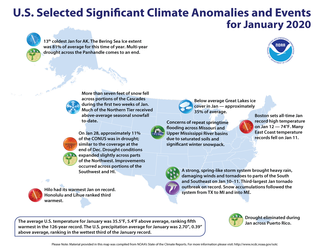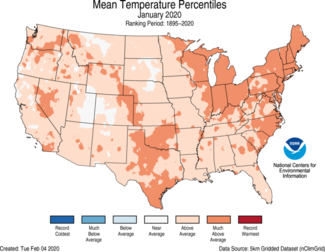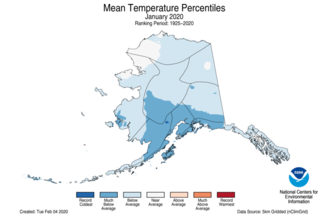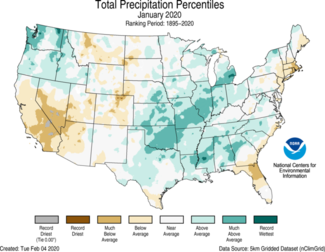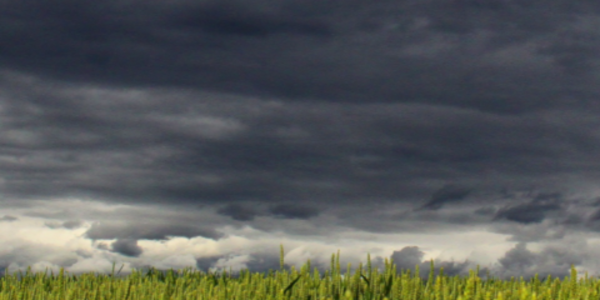Contiguous U.S. fifth warmest for January, Great Lakes ice cover well-below average
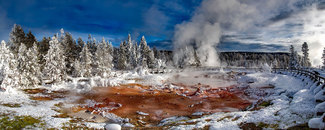
During January, the average contiguous U.S. temperature was 35.5°F, 5.4°F above the 20th century average, ranking fifth warmest in the 126-year record. This was the ninth consecutive January with temperatures at least nominally above the 20th century average for the month.
The January precipitation total for the contiguous U.S. was 2.70 inches, 0.39 inch above average, and ranked in the wettest third of the 126-year period of record. The February 2019–January 2020 precipitation total was 34.95 inches, 4.99 inches above average and ranked third wettest for this 12-month period.
This monthly summary from NOAA National Centers for Environmental Information is part of the suite of climate services NOAA provides to government, business, academia and the public to support informed decision-making.
January Temperature
-
Much-above-average temperatures were observed across much of the Great Lakes and Northeast as well as parts of the Mid-Atlantic, Southeast, the southern Plains and West. Michigan ranked fifth warmest, while Wisconsin and Rhode Island ranked sixth warmest. No state in the Lower 48 ranked average or below average for the month.
-
Temperatures during the first part of winter were warm enough across the Great Lakes to keep surface water temperatures above freezing across a large portion of the basin. As a result, lake-effect snow events become possible much later in the season than on average, which can lead to higher seasonal snowfall totals. Basin-wide ice cover spiked briefly at the end of January — approximately 35 percent of average for this time of year. Lake Erie, which averages just over 50 percent ice coverage at the end of January, was only 0.4 percent frozen on January 31.
-
-
In stark contrast to the record warmth experienced during 2019, the Alaska average January temperature was −6.2°F, 8.4°F below the long-term mean. This tied with 1970 as the 13th coldest January on record for the state and the coldest January since 2012.
-
McGrath ranked fourth coldest while Kodiak and King Salmon ranked fifth coldest for the month. The coldest average temperature reported across the state during January was −30.4°F in Chicken, AK — 9.5°F below average. The coldest daily minimum temperature of −62°F was also reported in Chicken on January 10.
-
Cold January temperatures aided in the recovery of the Bering Sea Ice extent during January, which increased to 81 percent of average for this time of year.
-
January Precipitation
-
During January, much-above-average wetness was observed across the Pacific Northwest as well as portions of the central and southern U.S. The state of Washington ranked fourth wettest while Oklahoma ranked sixth wettest on record.
-
Below-average precipitation occurred across much of the Southwest, Florida and portions of the High Plains and Northeast. Rhode Island ranked sixth driest and Massachusetts ranked tenth driest for January.
-
Alaska had its 14th driest January since records began in 1925 and the driest January since 2006. The Central Interior division was record dry for the month. Despite the below-average statewide precipitation, snowfall was plentiful across the Panhandle and other near-coastal locations.
-
According to the January 28 U.S. Drought Monitor report, approximately 11 percent of the contiguous U.S. was in drought, similar to the coverage at the end of December. Drought conditions expanded and shifted slightly across parts of Oregon, the state of Washington and Idaho. Improvements occurred across portions of the Southwest and Hawaii, while drought was eliminated in both Alaska and Puerto Rico during January.

